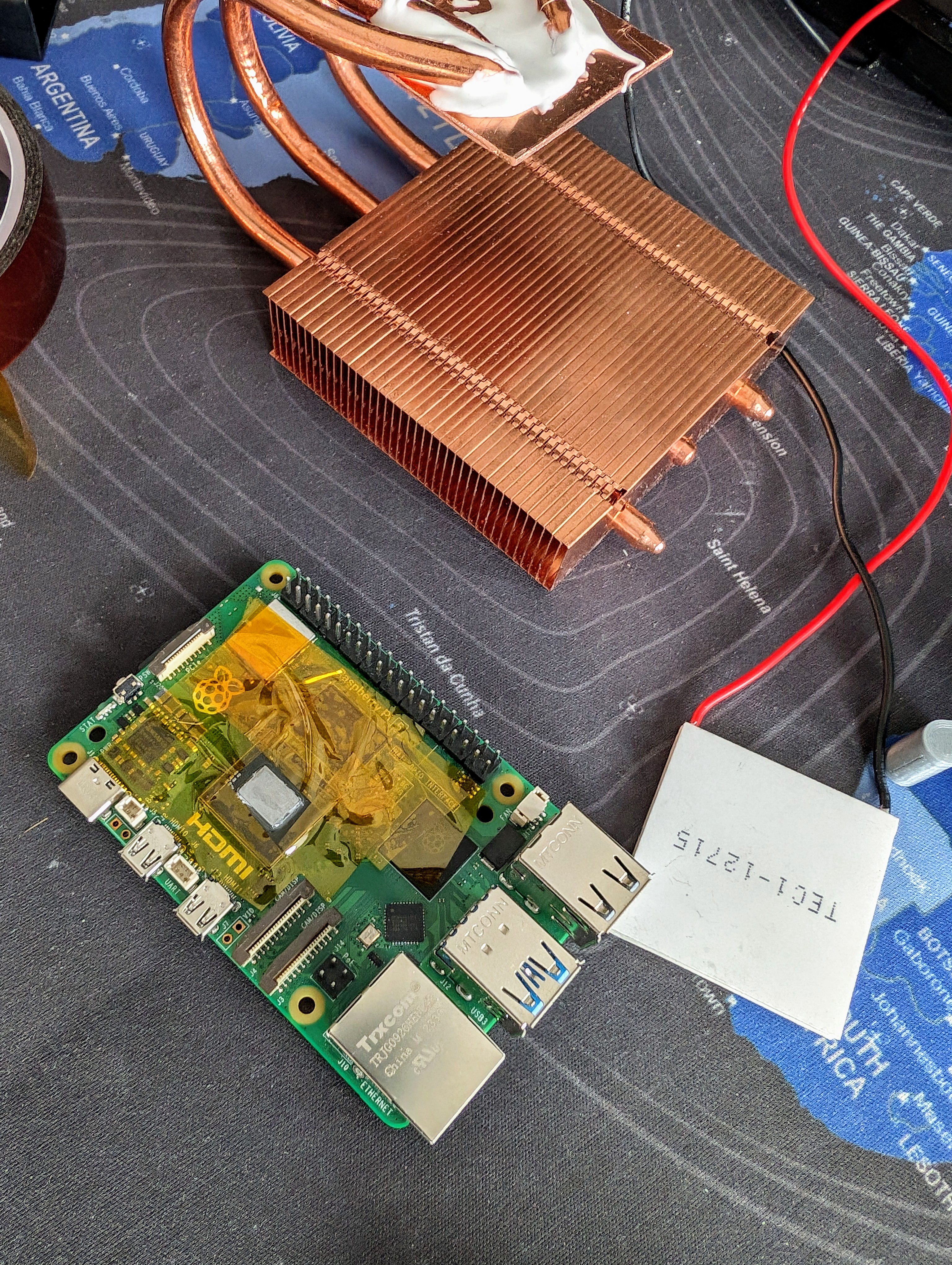Raspberry Pi 5 delidded and topped with Peltier element for the ultimate cooling test
Super-cool

Intrepid maker Ivan Kuleshov has delidded a Raspberry Pi 5 for the maximum cooling possible! Not content with the typical IHS, Kuleshov has added a Peltier element and a series of heatpipes that take the heat to a large copper heatsink.
I delidded Raspberry Pi 5 CPU and made a custom cooling system with thermal tubes and Peltier element.In theory, it is possible to reach sub-zero temperatures.Testing is in progress. Results will be up soon in a thread here and on my site#raspberrypi #raspberrypi5 pic.twitter.com/29ZXcwmMsqJanuary 19, 2024
Delidding any CPU is not for the faint of heart. One wrong move, and you have a paperweight, so don't try this unless you know your stuff. Delidding exposed the BCM2712 SoC, comprising an Arm Cortex-A76 64-bit CPU running at 2.4 GHz and a VideoCore VII GPU running at 800 MHz. We can see that Kuleshov has employed plenty of Kapton tape around the board, isolating the components from touching any conductive materials. In our review we noted that the Raspberry Pi 5 is known to get hot, that's why for a few dollars more you can (and you really should) pick up an active cooler.



However, the active cooler wasn't enough for Kuleshov. Instead, they chose a Peltier element, a thermoelectric cooler that uses the Peltier effect. The "hot side" of the element connects to the heatsink, and the cool to the SoC. Flow a little DC current, and your Raspberry Pi 5 gets a cooling boost!
Holding the element to the SoC is a custom 3D-printed jig that also keeps three copper heatpipes in place. These pipes pull the heat from the element and down into a copper heatsink. This is all passive cooling; there is no active fan cooling here! That means the copper heatsink is slightly larger than the Raspberry Pi 5. It also makes for a novel-looking Raspberry Pi for your desk.
How well does it cool? Kuleshov doesn't know yet. The project is mere hours old, and Kuleshov is running a few tests to provide us with the numbers. They theorize that a Peltier element could reach sub-zero degrees Celsius; how this translates to Pi cooling, we can't wait to find out.
Get Tom's Hardware's best news and in-depth reviews, straight to your inbox.

Les Pounder is an associate editor at Tom's Hardware. He is a creative technologist and for seven years has created projects to educate and inspire minds both young and old. He has worked with the Raspberry Pi Foundation to write and deliver their teacher training program "Picademy".
-
bit_user Peltiers almost never make sense, which is why they've fallen into disfavor among the PC community. They produce too much waste heat for the good they do.Reply
The only time I've seen peltiers make sense was to cool a fairly low-power component below room temperature, but there was a waterblock sitting on top of the peltier stack to remove all the heat. Furthermore, it required careful condensation controls, because such a setup will attract water like an ice cold drink on a warm summer evening.
Maybe it'll work in this case, simply due to how little heat the Pi's SoC, itself, actually generates. IMO, it's still not worth dealing with condensation. -
BillyBuerger Yeah, while the Pi 5 may run hot for a little chip, any decent sized heat sink, especially with some heat pipes would easily keep it cool. I assume they're doing it just for kicks. Because Peltier makes no sense for cpu cooling.Reply -
CerianK Reply
Usually not an issue as long as the CPU stays at 15C or above, which would require temperature feedback to the Peltier controller. This, of course, would only allow marginal overclock headroom, as the Peltier would be swamped quickly, as it is limited to about 5W of net dissipation improvement.bit_user said:IMO, it's still not worth dealing with condensation.
I used to work on these double-stacked in a vacuum chamber... -40C/F was doable when the chip they were cooling (photo diode array) was low wattage. The external enclosure was water pumped at 15C with no condensation issues. -
bit_user Reply
For astrophotography? That's the application I'm familiar with. Yes, you need a vacuum chamber. This camera had a 4-stage TEC stack. An ion pump was used to maintain a sufficient vacuum inside the chamber.CerianK said:I used to work on these double-stacked in a vacuum chamber... -40C/F was doable when the chip they were cooling (photo diode array) was low wattage. The external enclosure was water pumped at 15C with no condensation issues. -
froggx ReplyThis is all passive cooling; there is no active fan cooling here!
there's a fan pointed at the heatsink in the pic right above this paragraph, one of the black centrifugal-flavored blowers like they use in laptops... -
bit_user Reply
Good eye.froggx said:there's a fan pointed at the heatsink in the pic right above this paragraph, one of the black centrifugal-flavored blowers like they use in laptops...
If the maker was touting its passive nature, maybe the fan is just there to find out how much better it works with active cooling. Perhaps all will become clear in the follow-up article, where we find out how high it clocks.